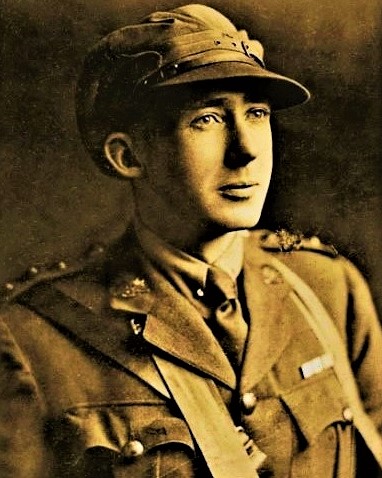The greatest ever.
The photograph is of Captain George Meysey Hammond MC and Bar, MM, of the 28th Battalion, from Broome, Western Australia. A very brave man.
I find it very sad that George Hammond is not nationally known. There is a newspaper article about him dated the 3rd of May 1934, headlined “The Greatest Ever”.
The photograph was probably taken just before his departure for the Somme, where he was awarded a bar to his MC (Military Cross) for heroism at Morlancourt. He is wearing an officer’s cap of British manufacture.
He was awarded the Military Medal (MM) as a sergeant for his bravery near Bois Grenier, France on the 2nd of June 1916, when, under heavy fire, he went forward to gather important reconnaissance on enemy bombardments.
George Hammond was wounded in the leg at Pozieres on the 29th of July, leaving him with an enduring limp, the same day that he was commissioned a second lieutenant..
He incurred a second more serious wound on the 5th of November at Flers when his elbow was shattered, rendering his left arm permanently useless, which had to be supported in a sling. You can see the sling in his photograph. In January 1917 he was promoted to lieutenant.
Despite the handicaps resulting from his wounds, George Hammond convinced the authorities to return him to front line service.
For his actions as an Intelligence Officer near Westhoek on the 20th of September 1917, he was awarded the Military Cross (MC). With only one functioning arm and the added handicap of a walking stick, he managed to single-handedly capture 20 German prisoners and gather important information.
On Christmas Day, George Hammond had a narrow escape from a sniper when a bullet was stopped by his field notebook and cigarette case as it tore through his breast pocket.
In early 1918, he was posted to the Australian War Records Section in England but following numerous appeals to his superiors, he returned to his battalion in France in May as captain in command of ‘A’ company.
His actions near Morlancourt on the 10th of June 1918, were recognised with the award of a further MC, represented by a bar on the ribbon of the original medal. During the fighting he moved across no-mans-land, ten metres in front of his men, directing the attacking line with his walking stick hanging from his useless left arm and a watch in his right hand..
Despite the danger, he frequently had his back to the enemy, while following closely behind the creeping artillery barrage, and would occasionally straighten the line with a wave of his stick.
When his men followed him into the German trench, George Hammond had already captured a number of enemy prisoners. He was mortally wounded by a sniper’s bullet the following day and died on the 14th.
A fellow officer said of George Hammond… ‘I am quite sure that [he] did not know what fear meant… I never once saw him duck for either a shell or a bullet’.
Captain Hammond is buried in Vignacourt Cemetery.
He was also known as Meysey George Hammond, and was born on the 3rd of July 1892, in England. He immigrated to Australia in 1911.
Lest We Forget.
Photograph and information came from the Australian War Memorial. Image file number AWM A03367.
Webpage for World War 1 – Australian War Heroes
